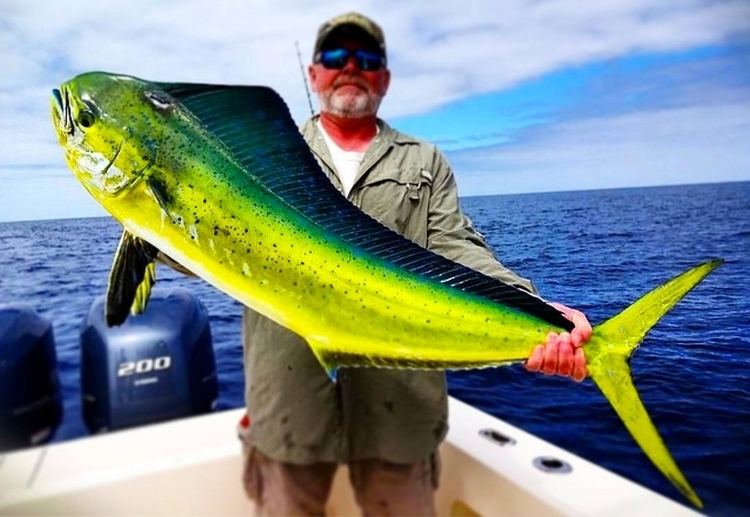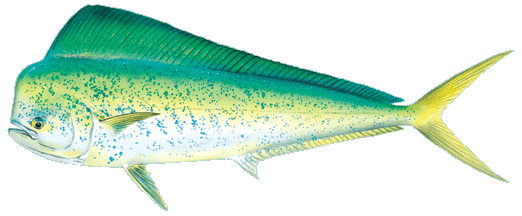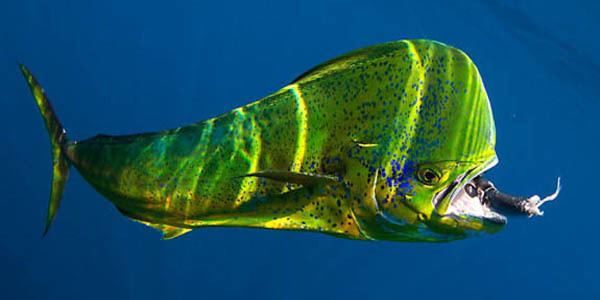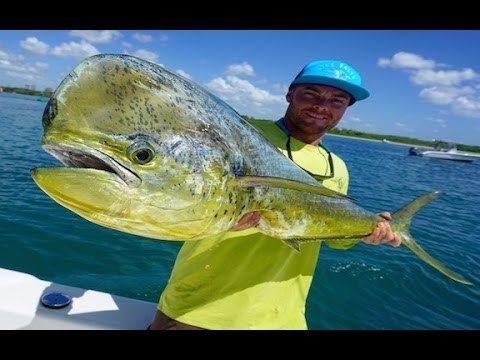Family Coryphaenidae Lifespan 7 years Rank Species | Phylum Chordata Order Perciformes Genus Coryphaena Mass 22 kg (Adult) Length 86 – 140 cm | |
 | ||
Conservation status Least Concern (Population stable) Similar Fish as food, Marlin, Yellowfin tuna, Tuna, Swordfish | ||
The mahi-mahi (/ˈmɑːhiːˈmɑːhiː/) or common dolphinfish (Coryphaena hippurus) is a surface-dwelling ray-finned fish found in off-shore temperate, tropical and subtropical waters worldwide. Also widely called dorado and dolphin, it is one of two members of the Coryphaenidae family, the other being the pompano dolphinfish. Mahi means very strong in Hawaiian.
Contents
- Nomenclature
- Description
- Recreational fishing
- Commercial fishing
- Environmental and food safety concerns
- References

Nomenclature

The name mahimahi means very strong in Hawaiian. In other languages, the fish is known as dorade coryphène, dorado, dolphin, lampuga, llampuga, lampuka, lampuki, rakingo, calitos, ti-rone or maverikos.

The common English name of dolphin causes much confusion. Additionally, two species of dolphinfish exist, the common dolphinfish (Coryphaena hippurus) and the pompano dolphinfish (Coryphaena equiselis). Both these species are commonly marketed by their Pacific name, mahi-mahi. Being fish, they are not related to dolphins. See Coryphaena for the possible etymologies of "dolphinfish".
The fish is called mahi-mahi in the Hawaiian language, and "mahi mahi" is commonly used elsewhere.

In the Pacific and along the English speaking coast of South Africa they are also commonly called by the Spanish name, Dorado. In the Mediterranean island of Malta, this fish is referred to as the lampuka.

Linnaeus named the genus, derived from the Greek word, κορυφή, koryphe, meaning top or apex, in 1758. Synonyms for the species include Coryphaena argyrurus, Coryphaena chrysurus and Coryphaena dolfyn.
Description

Mahi-mahi have compressed bodies and a single long-based dorsal fin extending from the head almost to the tail. Mature males have prominent foreheads protruding well above the body proper. Females have a rounded head. Their caudal fins and anal fins are sharply concave. They are distinguished by dazzling colors: golden on the sides, and bright blues and greens on the sides and back. The pectoral fins of the mahi-mahi are iridescent blue. The flank is broad and golden. Out of the water, the fish often change color (giving rise to their Spanish name, dorado, "golden"), going though several hues before finally fading to a muted yellow-grey upon death.
Mahi-mahi can live up to 5 years, although they seldom exceed four. Females are usually smaller than males. Catches average 7 to 13 kilograms (15 to 29 lb) and a meter in length. They rarely exceed 15 kilograms (33 lb), and mahi-mahi over 18 kilograms (40 lb) are exceptional. Mahi-mahi are among the fastest-growing of fish. They spawn in warm ocean currents throughout much of the year, and their young are commonly found in rafts of Sargassum weeds. Mahi-mahi are carnivorous, feeding on flying fish, crabs, squid, mackerel, and other forage fish. They have also been known to eat zooplankton and crustaceans.
Males and females are sexually mature in their first year, usually by 4–5 months old. Spawning can occur at body lengths of 20 cm. Females may spawn two to three times per year, and produce between 80,000 and 1,000,000 eggs per event. In waters averaging 28 °C/83 °F, mahi-mahi larvae are found year-round, with greater numbers detected in spring and fall. Mahi-mahi fish are mostly found in the surface water. Their flesh is soft and oily, similar to sardines. The body is slightly slender and long, making them fast swimmers; they can swim as fast as 50 knots (92.6 km/h, 57.5 mph).
Recreational fishing
Mahi-mahi are highly sought for sport fishing and commercial purposes. Sport fishermen seek them due to their beauty, size, food quality, and healthy population. Mahi-mahi can be found in the Caribbean Sea, on the west coast of North and South America, the Pacific coast of Costa Rica, the Gulf of Mexico, the Atlantic coast of Florida and West Africa, South China Sea and Southeast Asia, Hawaii, Tahiti and many other places worldwide.
Fishing charters most often look for floating debris and frigatebirds near the edge of the reef in about 120 feet (37 m) of water. Mahi-mahi (and many other fish) often swim near debris such as floating wood, five gallon bucket lids, palm trees and fronds, or sargasso weed lines and around fish buoys. Frigatebirds dive for food accompanying the debris or sargasso. Experienced fishing guides can tell what species are likely around the debris by the birds' behavior.
Thirty- to fifty-pound gear is more than adequate when trolling for mahi-mahi. Fly-casters may especially seek frigatebirds to find big mahi-mahis, and then use a bait-and-switch technique. Ballyhoo or a net full of live sardines tossed into the water can excite the mahi-mahis into a feeding frenzy. Hookless teaser lures can have the same effect. After tossing the teasers or live chum, fishermen throw the fly to the feeding mahi-mahi. Once on a line, mahi-mahi are fast, flashy and acrobatic, with beautiful blue, yellow, green and even red dots of color.
Commercial fishing
The United States and the Caribbean countries are the primary consumers of this fish, but many European countries are increasing their consumption every year. It is a popular eating fish in Australia, usually caught and sold as a by-product by tuna and swordfish commercial fishing operators. Japan and Hawaii are significant consumers. The Arabian Sea, particularly the coast of Oman, also has mahi-mahi. At first, mahi-mahi were mostly bycatch (incidental catch) in the tuna and swordfish longline fishery. Now they are sought by commercial fishermen on their own merits.
In French Polynesia, fishermen use harpoons, using a specifically designed boat, the poti marara, to pursue it, because mahi-mahi do not dive. The poti marara is a powerful motorized V-shaped boat, optimized for high agility and speed, and driven with a stick so the pilot can hold his harpoon with his right hand. The practice is also done by fishermen in the Philippines, especially in the northern province of Batanes, where the harpooning is called pagmamamataw.
Environmental and food safety concerns
Depending on how it is caught, mahi-mahi is classed differently by various sustainability rating systems:
The mahi-mahi is also a common vector for ciguatera poisoning.
